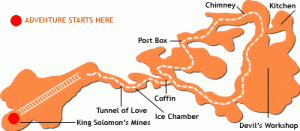Eventually, we left on our overland tour the following day and crossed over into Namibia; from the second we crossed into Namibia, the entire landscape changed dramatically. We spent the night at Felix Unite, camping along the Orange River. The make the most of our day, Michelle and I decided to go canoeing down Orange River with some other people in our group.
To get to our start point, we were driven 10km through the deserted valley while standing on the bed of a truck – that in and of itself was a lot of fun. We were surrounded by gorgeous views during our leisurely canoe experience, and the water splashing us was very much welcomed on a sweltering hot day. 2.5 hours later, we completed our canoeing journey – sunburned, exhausted, and dehydrated.
We spent the evening watching the sunset at Fish River Canyon, which is the second largest canyon in the world (160 km long, 127 km wide, and .5km deep). To see the sunset behind such a vast canyon is really something but, unfortunately, it was a bit hazy. With cheese, crackers, and beers in hand, it was a good sundowners indeed.
The following day, we drove through the Zaris Mountains and continued along the Naukluft Mountains after lunch. We made it to our campsite and before even setting up our tent, Michelle and I ran in the pool – it was 40 degrees (104 Fahrenheit)! Later in the day, we headed to the Sesriem Canyon; Sesriem means “six ropes.” We went down into the canyon (1.6 km long, 30 m deep, and only 2 m wide in some places) and wandered around for a while before heading up for another sunset.

































































